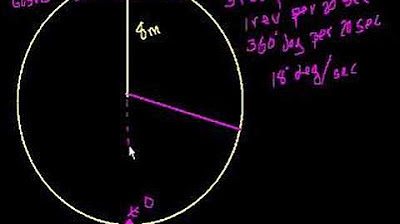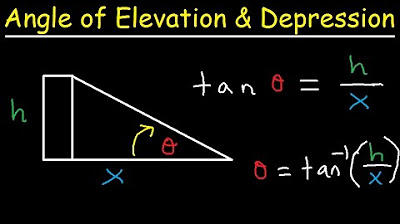Ferris Wheel problem for Precalculus
TLDRThe video script discusses a Ferris wheel problem involving a 60-foot diameter wheel with a 35-foot vertical center from the ground. It revolves every 80 seconds, and the challenge is to determine how long it takes for a rider starting at the bottom to reach a height of 50 feet. The instructor outlines the process to create a sinusoidal function that models the rider's height over time, explaining concepts like amplitude, equilibrium line, and period. They demonstrate how to graph the function using Desmos and a calculator to find the specific times when the rider's height is 50 feet, emphasizing the importance of understanding the function's parameters and the flexibility in choosing between sine and cosine functions.
Takeaways
- 🎡 The Ferris wheel in the problem has a diameter of 60 feet, which means its radius is 30 feet.
- 🏗️ The center of the Ferris wheel is 35 feet above the ground, indicating a vertical shift in the problem setup.
- 🚶♂️ Riders do not enter the Ferris wheel from ground level to avoid dragging their feet on the ground.
- ⏱ The Ferris wheel completes one revolution every 80 seconds, which is the period of the motion.
- 📈 The task is to find a mathematical function that models the height of a rider on the Ferris wheel over time.
- 📚 Homework involves finding functions for sinusoidal curves, which are relevant to this Ferris wheel problem.
- 📉 The sinusoidal curve can be represented using either a sine or cosine function, depending on the starting point and direction of the motion.
- 🔄 The amplitude of the motion is 30 feet, which is the diameter of the Ferris wheel, representing the maximum distance from the equilibrium line.
- 📐 The equilibrium line is halfway between the maximum and minimum heights of the rider's motion.
- 🔢 The period of the function is determined by the Ferris wheel's revolution time, which is 80 seconds or 2π/B, where B = π/40 in this case.
- 📊 The problem can be solved using graphing calculators or software like Desmos to visualize and find specific points on the curve, such as when the height is 50 feet.
Q & A
What is the diameter of the Ferris wheel mentioned in the script?
-The diameter of the Ferris wheel is 60 feet.
How long does it take for the Ferris wheel to make a full revolution?
-The Ferris wheel makes a full revolution every 80 seconds.
What is the vertical shift mentioned in the script, and why is it necessary?
-The vertical shift mentioned is 35 feet, which is the height of the center of the wheel from the ground. It's necessary because riders never enter the Ferris wheel from ground level to avoid their feet dragging against the ground.
What is the task given to the students regarding the Ferris wheel problem?
-The task given to the students is to find the functions for sinusoidal curves that represent the motion of a rider on the Ferris wheel.
What is the height at which the rider starts his journey on the Ferris wheel?
-The rider starts his journey at a height of 5 feet from the ground.
What is the height the rider needs to reach, and how many times will they reach this height during one revolution?
-The rider needs to reach a height of 50 feet, and they will reach this height at two different points during one revolution.
What are the key components of a sinusoidal function that the students need to consider?
-The key components include the equilibrium line, amplitude, vertical and horizontal shifts, and the period of the function.
What is the period of the sinusoidal function representing the Ferris wheel's motion?
-The period of the sinusoidal function is 80 seconds, which is the time it takes for the Ferris wheel to complete one full revolution.
How can the students represent the sinusoidal curve for the Ferris wheel's motion?
-The students can represent the sinusoidal curve using either a sine function or a cosine function, with appropriate adjustments for amplitude, vertical shift, and horizontal shift.
What is the amplitude of the sinusoidal function in the example provided?
-The amplitude of the sinusoidal function in the example is 30, which represents the distance from the equilibrium line to the maximum height reached by the rider.
How can the students use Desmos or a calculator to graph and solve the sinusoidal function?
-Students can use Desmos for its user-friendly interface and ability to zoom in and out, or a calculator to graph the function and find intersection points with other lines, such as the height of 50 feet.
What are the two solutions for the time it takes for the rider to reach a height of 50 feet?
-The two solutions for the time it takes for the rider to reach a height of 50 feet are approximately 26.67 seconds and 53.33 seconds.
Outlines
🎡 Ferris Wheel Motion Analysis
This paragraph introduces a mathematical problem related to the motion of a ferris wheel. The ferris wheel has a diameter of 60 feet and completes a revolution every 80 seconds. The center of the wheel is 35 feet above the ground, and the problem asks how long it takes for a rider starting at the bottom to reach a height of 50 feet. The paragraph discusses the vertical shift inherent in ferris wheel problems and the need to find a sinusoidal function to model the rider's height over time. Key concepts such as amplitude, equilibrium line, vertical and horizontal shifts, and period are explained. The period of the ferris wheel's motion is calculated using the formula 2π/B, where B is derived from the period of 80 seconds, resulting in B = π/40. The paragraph concludes with the beginning of a function using cosine with a negative amplitude and the vertical shift of +35 feet.
📈 Graphing the Ferris Wheel's Sinusoidal Motion
The second paragraph continues the discussion on the ferris wheel problem, focusing on graphing the sinusoidal motion. It explores the use of both sine and cosine functions to model the rider's height, considering horizontal shifts and amplitude adjustments. The paragraph explains how to represent the ferris wheel's motion using Desmos, a user-friendly graphing tool, and demonstrates how to input the function y = -30 cos(π/40 * t) + 35 to visualize the curve. It also shows how to find specific points on the curve, such as when the rider's height equals 50 feet, using both Desmos and a graphing calculator. The paragraph emphasizes the importance of understanding the different parameters of the sinusoidal function and how they affect the graph. It concludes by encouraging students to explore various forms of the function for their homework, acknowledging that there are multiple correct answers depending on the chosen model and shifts.
Mindmap
Keywords
💡Ferris Wheel
💡Diameter
💡Vertical Shift
💡Sinusoidal Curves
💡Amplitude
💡Equilibrium Line
💡Period
💡Horizontal Shift
💡Sine and Cosine Functions
💡Desmos
Highlights
Introduction to a Ferris wheel problem with a diameter of 60 feet and a revolution every 80 seconds.
Explanation of the vertical shift in Ferris wheel problems due to the entry point being above ground level.
The center of the wheel is 35 feet off the ground, affecting the starting height of the rider.
The task of finding the time for a rider to reach a height of 50 feet on the Ferris wheel.
Sketching the sinusoidal curve representing the rider's height over time.
Introduction to the concept of period in the context of sinusoidal functions.
Calculation of the amplitude and equilibrium line for the sinusoidal curve.
Differentiating between sine and cosine functions for representing the curve.
Explanation of vertical shifts, horizontal shifts, and period adjustments in sinusoidal functions.
Derivation of the value for B in the sinusoidal function to represent the period of 80 seconds.
Use of negative cosine to represent the Ferris wheel's motion with a starting height of 5 feet.
Alternative representations using sine function with horizontal shifts.
Emphasis on the flexibility in choosing between sine and cosine for the same graph.
Guidance on using Desmos for graphing sinusoidal functions and checking points.
Demonstration of finding the intersection points with the height of 50 feet using Desmos.
Use of a calculator to graph and find the intersection points for the sinusoidal function.
Highlighting the importance of understanding the origin of each value in the sinusoidal function.
Encouragement for students to explore different versions of the sinusoidal function for their homework.
Transcripts
Browse More Related Video

Ferris Wheel Trigonometry Problem

Sinusoidal Function Word Problems: Ferris Wheels and Temperature

Ferris Wheel MHF4U Modelling Trigonometric Functions Test

Ferris Wheel Trig Problem

MCR3U - Word Problems for Sine and Cosine Functions

Angle of Elevation and Depression Word Problems Trigonometry, Finding Sides, Angles, Right Triangles
5.0 / 5 (0 votes)
Thanks for rating: